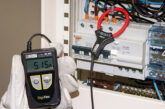
Now the 18th Edition Regs have arrived, do you need to upgrade your existing 17th Edition compliant test instruments at the same time? David Sweetman, Marketing & Business Development Director at Di-Log Test Equipment, offers his advice.
We’re regularly asked whether electricians have to invest in new or upgraded equipment in order to comply with the 18th Edition. In a way the simple answer is ‘no’, however, there may well be some additional items that you could consider adding to your test instrument inventory that will prove very useful.
What on Earth?
One change that’s been talked about on my travels is Earth Electrode testing. Having read through chapter 54 of the final draft of the 18th Edition, it looks like the requirement to perform earth electrode testing may well become essential for most electricians from January 2019.
This doesn’t mean that you’ll need to venture out and purchase a new MFT with this feature built-in, as there are plenty of standalone Earth Resistance Testers that are available at very affordable prices. There are also MFTs on the market with a built-in Earth Resistance function, however this in-built feature can come at quite a costly premium compared to buying one without.
In the Loop
One conundrum that’s had lots of instrument design engineers scratching their heads over recent times is the ability to return accurate and stable loop test results. Principally we’re asking the instruments to inject a current into a circuit and then return an accurate and acceptable Earth Loop result. Injecting a high current into a circuit will generate very reliable and accurate readings, however this can’t be done when protective devices are fitted in the circuit, such as RCDs or RCBOs.
Other issues that may arise on modern day circuits, especially now in the IT world we all live in, is noise or harmonics. IT equipment more commonly introduces noise interference onto an AC supply, causing small spikes on the waveform; just a few volts would cause your instrument’s readings to fluctuate. In addition to this, where RCDs and RCBOs are in place, they can become highly inductive when performing a loop test. This is known as ‘RCD uplift’. So again, design engineers are creating new technologies to overcome these day-to-day issues in the field.
In time for the 18th Edition, two manufacturers have recently launched solutions to this issue – Megger with its new MFT1741 and Di-Log with the new, patented RCD-LOC XLT loop system in place on the new DL9118 Installation MFT. The Di-Log unit uses a very clever algorithm designed to detect noise and ‘RCD uplift’. The RCD-LOC XLT Algorithm will perform an additional loop test specifically looking for the effects of noise and if RCD uplift is present. It will then return an accurate loop test result (with all the external effects removed) in around nine seconds.
Therm time
Other additions and clarification expanded in the new 18th Editions wiring regulations are a greater focus on Embedded Heating Systems – section 753, protection against Thermal Effects Chapter 42 and the addition of Energy Efficiency in Appendix 17.
Although the revised Guidance Note 3 isn’t due to be released until later this year, I wouldn’t be surprised if there is a greater emphasis on Thermographic Surveying where cameras, such as the FLIR C3 or FLIR Ex series, would effectively identify defects that wouldn’t normally be located by a visual inspection alone.
Energy efficiency is a new addition to the 18th Edition and this recommends careful planning and designing should be undertaken for new and existing installations. This will mostly apply to non-domestic installation. The use of Power Energy Loggers and Power Quality Analysers, such as Chauvin Arnoux’s PEL103 Logger or Qualistar Analysers, may be required to measure the characteristics of the supply, such as power factor correction.
Reduction of reactive current improves electrical energy efficiency by, for example, reducing thermal losses in wiring systems. The cross-sectional areas of conductors may be optimised to reduce losses amongst other recommendations, with lighting control being one of the easiest ways to improve energy efficiency. Therefore, careful consideration should be given to lighting control and design.
For more information about the DL9118 MFT from Di-Log visit: www.dilog.co.uk









